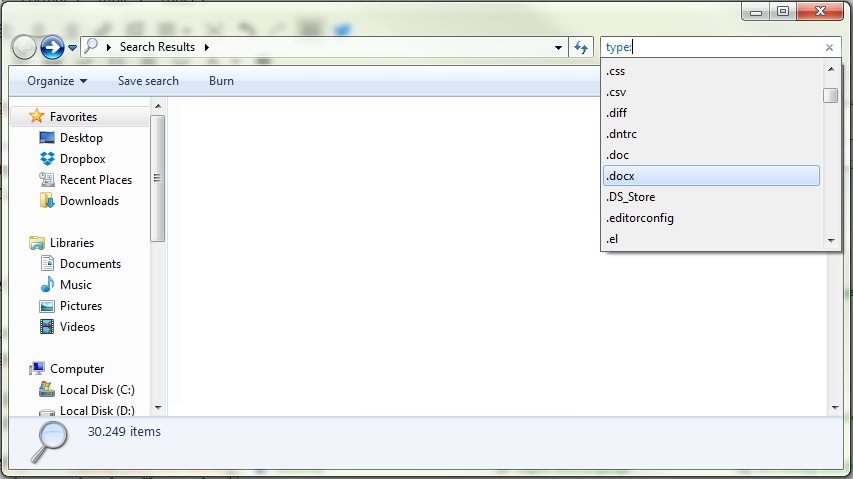
Windows 7 File Search
Windows 7 brought with it a completely new look for Windows. It also brought a bit of a change to file search. In this version of Windows, you need to use Windows Explorer to search through your files and folders.
File Search didn’t exactly become more complicated with the change, but some of the default indexing rules changed. If you find that your searches aren’t bringing up the correct files and folders, then you might want to check which folders are actually being indexed.
If the folders you need the file search utility to look through aren’t being indexed, then your results won’t show anything from these folders. This is easily fixed by placing the folders in one or more of your libraries in Windows 7, since those are the locations that Windows 7 will look through by default. Just organize your libraries to your liking and your results will be more accurate. A little extra search tip for Windows 7:
You can use size operators to narrow down your file search, just type in Size: Gigantic or Size:>= 128mb (or a different unit of size). There are some specific properties that go along with the different size ranges:
- Empty: 0kb files
- Tiny: 0-10kb
- Small: 10-100kb
- Medium: 100kb-1mb
- Large: 1mb-16mb
- Huge: 16mb-128mb
- Gigantic: larger than 128mb
Windows 8 File Search
When you update from Windows 7 to 8, you will once again notice a slight difference in the Windows search tool. With previous versions of the OS, you accessed search from the Start Menu, but in Windows 8 you have a brand new full screen Start Search. This is due to the fact that the newer versions of Windows are so app based.
There are several ways to access your file search, or as it is called in Windows 8, File Explorer, just perform one of the following three steps:
- Type ‘File’, then click on the result that says File Explorer. This opens the search tool.
- Another way to access the File Explorer is to move the mouse to the lower left corner of your screen, right-click. When the menu pops up, choose ‘File Explorer’.
- Lastly, tap WINKEY+E and File Explorer will open up right away. This is the quickest way to start a new file search.
Windows 10 File Search
You guessed it; Desktop Search in Windows 10 is also slightly different from Windows 8. Thankfully, Windows 10 seems to have taken inspiration from the way file search worked in Windows 7; keeping the ‘File Explorer’ name from Windows 8 but returning to the more user friendly start menu search we all loved in 7.
The start menu is your go-to place to start a file search. To open File Explorer just start typing in the search bar. You can also just right click the Start Menu icon, and open File Explorer from there. The quickest way is to press WINKEY + E from anywhere in Windows.
Once you are in, you just need to start typing what you are looking for in the search box located at the top right. If you just need to search through your documents, then select Documents when you have File Explorer open. If you need to do a file search on your entire computer then you will need to select C: drive.
Microsoft made some noteworthy changes to File Explorer in Windows 10; here are some of the most helpful:
- OneDrive is now a part of your File Explorer.
- When you first open File Explorer, it will open to Quick access. Listed in Quick access are your frequently used files and folders, so if you are just looking for something you recently worked on, just stick with Quick access. It will also allow you to pin some of your favorite folders to the Quick access drop down list.
- Note that if you were using Windows 7 before this, “My Computer” is now called “This PC”.
- Your Libraries won’t show up in File Explorer unless you actually want them to show up. It is easy to add the Libraries to the left pane, just select View Tab>Navigation Tab>Show Libraries.
Problems with File Search
If you begin to run into a lot of search issues, where none of your results are coming up, then your best bet is to rebuild the index. This process is the same in Windows 7, 8 and 10:
- Go into Indexing Options (found in the Control Panel)
- Click on the Advanced button
- Make sure you are in the Index Settings tab
- Underneath where it says Troubleshooting, just click on the Rebuild
The rebuild could take up some time. Just let it run. File search using Explorer should be no problem after the index has finished rebuilding.
No matter which version of Windows you are using, your computer should be able to handle most of your desktop search needs. If you feel like you need something more, there are many Windows Search alternatives out there. For now, happy searching!



Leave a Reply